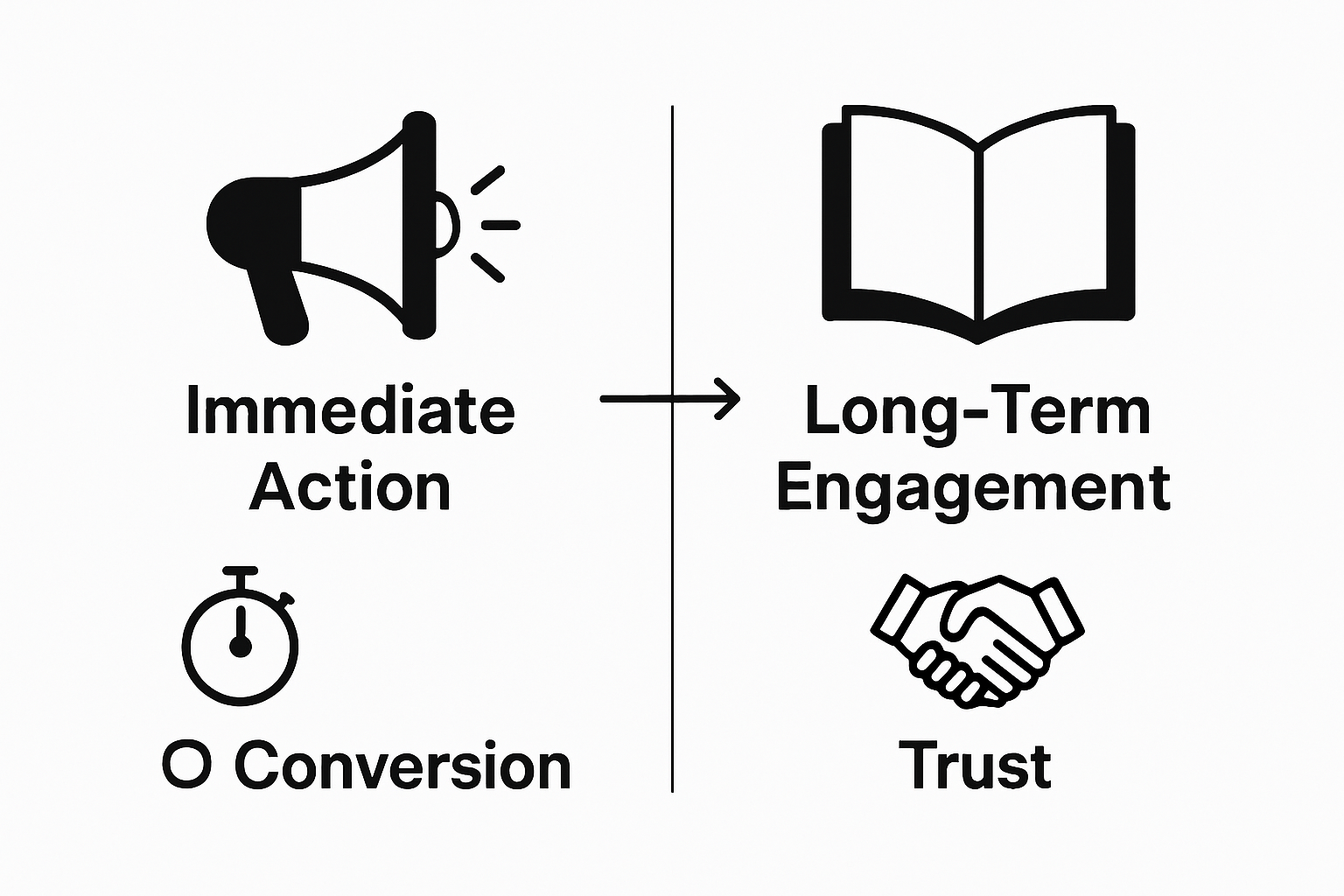Understanding Copywriting vs Content Writing: Key Differences
Copywriting and content writing seem almost interchangeable and both fill our feeds and inboxes every day. But their differences run deeper than you might expect. Copywriting powers short ads that can raise conversion rates by up to 113 percent, while content writing could stretch to a thousand words or more just to grow trust. Here’s the surprise. Most brands focus only on one and leave money on the table by ignoring the secret synergy created when both styles are used together.
Table of Contents
- Defining Copywriting And Content Writing: What They Are
- The Importance Of Copywriting And Content Writing In Marketing
- Key Differences And Similarities Between Copywriting And Content Writing
- How Copywriting And Content Writing Influence Consumer Behavior
- Real-World Applications Of Copywriting And Content Writing
Quick Summary
| Takeaway | Explanation |
|---|---|
| Copywriting prompts immediate actions | It focuses on persuasion to encourage quick responses, such as purchases or sign-ups, using compelling language. |
| Content writing builds long-term relationships | This approach aims to inform and engage audiences over time, fostering trust and authority through valuable content. |
| Both are essential for marketing success | While distinct, integrating copywriting and content writing creates effective communication strategies that resonate with audiences. |
| Understand your audience’s psychology | Successful messaging requires insight into consumer behavior to address emotional triggers and foster engagement effectively. |
| Leverage specific writing techniques for industries | Tailoring writing strategies to each industry’s unique nuances enhances clarity and engagement, making content more relatable and impactful. |
Defining Copywriting and Content Writing: What They Are
Copywriting and content writing represent two distinct yet interconnected approaches to professional writing, each serving unique purposes in marketing and communication strategies. While both aim to engage audiences, their core objectives and methodologies differ significantly.
The Core Purpose of Copywriting
Copywriting is a specialized form of persuasive writing designed to drive specific actions from readers. Its primary goal is to motivate audiences toward an immediate response, typically a purchase, sign-up, or engagement with a brand. According to the American Marketing Association, copywriting is fundamentally about “selling people on an idea, brand, or ideology” through direct and compelling language.
Key characteristics of copywriting include:
- Sharp, concise messaging
- Strong call-to-action statements
- Emotional and psychological triggers
- Focus on conversion and immediate results
Understanding Content Writing
Content writing takes a broader, more educational approach to communication. Unlike copywriting’s direct sales focus, content writing aims to inform, entertain, and build long-term relationships with audiences. As Creative Writing Education explains, it encompasses digital content designed to increase online visibility and answer consumer questions.
Fundamental aspects of content writing include:
- In-depth, valuable information
- Search engine optimization
- Building brand authority
- Establishing trust through expertise
While copywriting seeks immediate action and content writing pursues sustained engagement, both are crucial in modern digital communication strategies.
To clarify the major distinctions between copywriting and content writing, the following table compares their primary objectives, scope, and techniques as described in the article.
| Aspect | Copywriting | Content Writing |
|---|---|---|
| Main Goal | Drive immediate action (conversion, purchase, sign-up) | Build trust, inform, educate over the long term |
| Messaging Style | Concise, persuasive, focused on emotional triggers | Informative, detailed, focused on providing value |
| Typical Length | Short (ad headlines, CTAs, product slogans) | Medium to long (blogs, articles, whitepapers) |
| Success Metrics | Conversion rate, clicks, sales | Engagement, shares, time on page, brand authority |
| Primary Techniques | Calls to action, urgency, psychological triggers | SEO optimization, in-depth research, storytelling |
| Example Outputs | Sales emails, landing page copy, ads | Blog posts, guides, educational resources |
The Importance of Copywriting and Content Writing in Marketing
In the dynamic world of digital marketing, copywriting and content writing serve as critical communication tools that drive brand engagement, customer acquisition, and business growth. While distinct in their approaches, both writing styles play pivotal roles in creating compelling narratives that connect businesses with their target audiences.
Strategic Communication and Brand Positioning
Copywriting and content writing are fundamental to establishing a brand’s voice and market positioning. Our guide on creating educational content highlights how strategic communication can transform audience perception. According to Cornell University’s eCornell program, delivering the right message to the right audience at the right time is key to marketing success.
Key strategic communication objectives include:
- Establishing brand credibility
- Differentiating from competitors
- Creating emotional connections
- Communicating unique value propositions
Driving Customer Engagement and Conversion
Effective writing goes beyond mere information delivery. It transforms passive readers into active participants and potential customers. Copywriting focuses on immediate action triggers, while content writing nurtures long-term relationships through valuable, informative content.
Critical engagement strategies involve:
- Crafting compelling narratives
- Understanding audience psychology
- Providing solutions to specific problems
- Creating trust through consistent messaging
Ultimately, successful marketing hinges on the ability to communicate clearly, persuasively, and authentically. By leveraging both copywriting and content writing techniques, businesses can create powerful communication strategies that resonate with their target audience and drive meaningful business outcomes.
Key Differences and Similarities Between Copywriting and Content Writing
While copywriting and content writing might seem similar on the surface, they represent distinct communication strategies with unique objectives and approaches. Understanding their nuanced differences and unexpected similarities helps marketers craft more effective messaging.
Fundamental Strategic Differences
The core distinction lies in their primary goals and audience engagement strategies. According to the University of Wisconsin’s Writing Center, copywriting is primarily persuasive and marketing-focused, aiming for immediate action, whereas content writing provides informative or educational material supporting long-term brand engagement.
Key strategic differences include:

- Timeframe of audience response
- Primary communication objectives
- Measurement of success metrics
- Emotional versus informational approach
Complementary Communication Techniques
Despite their differences, copywriting and content writing share critical communication foundations. Both disciplines require deep audience understanding, compelling storytelling, and the ability to communicate complex ideas clearly. Learn more about crafting educational content strategies that bridge these writing approaches.
Shared communication characteristics encompass:
- Clear, concise language
- Audience-centric messaging
- Strong narrative structures
- Commitment to brand voice consistency
Integrated Marketing Communication Approach
Modern marketing demands a holistic approach where copywriting and content writing work synergistically. The most effective communication strategies integrate both disciplines, using content writing to build trust and credibility while leveraging copywriting to drive specific actions.
By recognizing the unique strengths of each writing style and understanding how they complement each other, businesses can create more nuanced, engaging marketing communications that resonate deeply with their target audiences.
How Copywriting and Content Writing Influence Consumer Behavior
Consumer behavior is profoundly shaped by strategic communication approaches, with copywriting and content writing playing pivotal roles in guiding audience perceptions, decisions, and actions. Understanding their psychological impact reveals how these writing techniques subtly yet powerfully influence purchasing motivations.
Psychological Triggers in Writing Strategies
Both copywriting and content writing leverage distinct psychological mechanisms to engage consumers. According to research from SagePub Journals, these communication strategies tap into different cognitive processing pathways, triggering varied emotional and rational responses.
Key psychological triggers include:
- Emotional resonance
- Social proof mechanisms
- Fear of missing out (FOMO)
- Solution-oriented storytelling
Persuasion and Trust-Building Dynamics
Copywriting typically employs direct persuasion techniques designed to prompt immediate action, while content writing cultivates long-term trust through informative and educational approaches. Explore our insights on brand voice development to understand how communication style impacts consumer perception.
Core persuasion strategies encompass:
- Creating perceived value
- Addressing consumer pain points
- Establishing credibility
- Demonstrating authentic brand personality
Conversion and Engagement Pathways
The ultimate goal of both writing styles is transforming audience engagement into measurable business outcomes. By understanding consumer psychology and crafting messages that resonate on emotional and rational levels, businesses can create communication strategies that not only attract attention but also drive meaningful consumer actions.
Through nuanced communication techniques, copywriting and content writing become powerful tools for shaping consumer perceptions, guiding decision-making processes, and ultimately influencing purchasing behaviors.
The following table highlights the ways copywriting and content writing influence consumer behavior by summarizing the psychological triggers and persuasion strategies found in both approaches.
| Influence Area | Copywriting Approach | Content Writing Approach |
|---|---|---|
| Psychological Triggers | Emotional resonance, FOMO, urgency | Social proof, solution-oriented storytelling |
| Persuasion Techniques | Direct calls-to-action, addressing pain points | Building credibility, demonstrating expertise |
| Trust Building | Authentic brand personality, perceived value | Consistency, education, long-term engagement |
| Consumer Response | Immediate actions (buy, sign up, click) | Informed decisions, repeat visits, loyalty |
Real-World Applications of Copywriting and Content Writing
Copywriting and content writing transcend theoretical concepts, finding critical applications across multiple business domains. Understanding how these writing strategies function in practical scenarios illuminates their transformative potential for organizational communication and marketing effectiveness.
Marketing and Advertising Implementations
In digital marketing landscapes, copywriting and content writing serve distinct yet complementary roles. Copywriting drives immediate conversions through compelling advertisements, landing pages, and sales messages, while content writing builds comprehensive brand narratives through blogs, whitepapers, and educational resources. Explore strategies to increase online sales that leverage these writing approaches effectively.
Practical marketing applications include:
- Email marketing campaigns
- Social media advertising
- Product description optimization
- Brand storytelling platforms
Digital Communication Channels
Modern businesses leverage different writing techniques across various digital platforms. Website content, social media posts, email newsletters, and multimedia scripts all require nuanced communication strategies that balance informative depth with persuasive messaging.
Key digital communication strategies encompass:
- Creating searchable, SEO-friendly content
- Developing consistent brand voice
- Adapting messaging for different platforms
- Engaging diverse audience segments
Industry-Specific Communication Approaches
Every industry demands unique communication nuances. Technology companies might prioritize technical clarity, while lifestyle brands focus on emotional storytelling. Effective copywriting and content writing adapt to sector-specific communication requirements, translating complex ideas into accessible, engaging narratives.
By mastering these writing disciplines, businesses can create powerful communication strategies that not only inform and persuade but also build lasting connections with their target audiences.

Transform Your Copywriting and Content Strategy into Real Email Results
Struggling to bridge the gap between engaging words and actual conversions? The article highlighted how understanding the difference between copywriting and content writing is essential for turning passive readers into loyal customers. Yet knowing the theory is just the start. The real challenge lies in translating insightful communication into measurable business growth and customer retention. Imagine every email campaign delivering sharp, persuasive copy that drives action and smart, informative content that builds lasting trust. That is the power of a strategy where storytelling meets conversion-focused execution.

If you want your ecommerce brand to send emails that truly reflect your unique brand voice, increase open and click rates, and drive more revenue, the solution is within reach. The experts at Take Action specialize in combining proven copywriting techniques with content-focused engagement inside sophisticated campaign strategies and automated flows. We tailor every message using Klaviyo to match what matters most for your business. Act now to connect human expertise and AI-driven insight so every email can do what it should—turn communication into growth. Ready to scale? Explore how we can help or book a call today.
Frequently Asked Questions
What is the main difference between copywriting and content writing?
Copywriting focuses on persuasive writing to drive immediate actions, such as purchases or sign-ups, while content writing aims to inform, educate, and build long-term relationships with audiences.
How does copywriting influence consumer behavior?
Copywriting employs emotional triggers, strong calls-to-action, and persuasive language to spur immediate actions from consumers, shaping their perceptions and encouraging purchases.
What are the key goals of content writing?
The main goals of content writing include providing valuable information, enhancing brand authority, answering consumer questions, and fostering trust through expertise and education.
Can copywriting and content writing be used together effectively?
Yes, when integrated, copywriting and content writing can create a holistic marketing strategy. Content writing can build trust and engage consumers, while copywriting can drive specific actions effectively.
Recommended
- Understanding Creating Educational Content for Brands | Take Action Blog | Take Action
- Understanding the Importance of Brand Voice for eCommerce | Take Action Blog | Take Action
- Growing a Personal Brand: Boost Your Influence by 2025 | Take Action Blog | Take Action
- Personalized Email Campaigns: A Growth Guide for 2025 | Take Action Blog | Take Action
- Essential Content Writing Techniques for 2025
